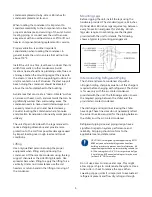
4
Each condenser has a two-way condenser water-
regulating valve. The condenser water-regulating
valve controls the amount of water allowed to pass
through the condenser in order to maintain proper
refrigeration pressures in the circuit.
To prevent damage to the condenser and/or water-
regulating valve, the water pressure should not
exceed 150 psig.
Water Pressure Gauges
Install pressure gauges in the inlet and outlet of both
the condenser and evaporator chilled water piping
to provide the ability to read the pressure drop
across the chiller and aid in preventive maintenance
and troubleshooting.
WARNING: Vent all refrigerant relief valves in accordance
to ANSI/ASHRAE Standard 15, Safety Code for Mechanical
Refrigeration. Locate this equipment in a well-ventilated
area. Inhalation of refrigerant can be hazardous to your
health and the accumulation of refrigerant within an
enclosed space can displace oxygen and cause suffocation.
WARNING: This equipment contains hazardous voltages
that can cause severe injury or death.
WARNING: This equipment contains refrigerant under
pressure. Accidental release of refrigerant under pressure
can cause personal injury and or property damage.
WARNING: This equipment may contain fan blades or
other sharp edges. Make sure all fan guards and other
protective shields are securely in place.
WARNING: The exposed surfaces of motors, refrigerant
piping, and other fluid circuit components can be very hot
and can cause burns if touched with unprotected hands.
CAUTION: Disconnect and lock out incoming power before
installing, servicing, or maintaining the equipment.
Connecting power to the main terminal block energizes
the entire electric circuitry of the unit. A power supply
provides 24 VDC control power. Shut off the electric power
at the main disconnect before opening access panels for
repair or maintenance.
CAUTION: Wear eye protection when installing,
maintaining, or repairing the equipment to protect against
any sparks, debris, or fluid leaks.
CAUTION: The equipment will exceed 70 dBA sound
pressure at 1 meter distance and 1 meter elevation when
operating. Wear ear protection as required for personal
comfort when operating or working in close proximity to
the chiller.
CAUTION: Wear protective gloves when installing,
maintaining, or repairing the equipment to protect against
any sparks, debris, or fluid leaks.
Master Temperature Sensor
This section only applies to installations where
multiple chillers are in a common system where one
chiller is the master with the other chillers serving as
slaves. In those situations, a field-installed master
fluid-temperature transmitter is required in the
common process fluid supply and return piping.
Install the sensor downstream of all individual chilled
water supply streams. Position the temperature
transmitter to read the mixed supply temperature.
The supply temperature transmitter is normally the
control sensor for the chiller system set point and
determines the loading/unloading of the
compressors of the system.
Mount the temperature transmitter in a ½” NPT
coupling in a minimum pipe size of 3”. The probe
sheath is ¼” OD x 3” in length and is equipped with
a ½” NPT male fitting for direct mounting in a
coupling. Use direct immersion mounting for the
most accurate reading and quickest response time. If
direct immersion mounting is not possible, mount
the sensor inside a thermowell to aid in maintenance
and or repair of the sensor if opening of the process
piping is not possible. Use a suitable heat transfer
compound with a thermowell. Wire from the
temperature transmitter to the chiller electrical
enclosure and landed at the designated terminal
blocks within the enclosure. Please see the chiller
electrical schematic provided for further detail.
Installation - Remote Condenser
Chillers designed for use with a remote air-cooled
condenser include a factory-selected remote
condenser. The remote air-cooled condenser
typically ships separately from a different location
than the chiller.
Location
The remote air-cooled condenser is for outdoor use.
Locate the remote condenser in an accessible area.
The vertical air discharge must be unobstructed.
Allow a minimum of 48 inches of clearance between
the sides and ends of the condenser and any walls or
obstructions. For installations with multiple
condensers, allow a minimum of 96 inches between











































